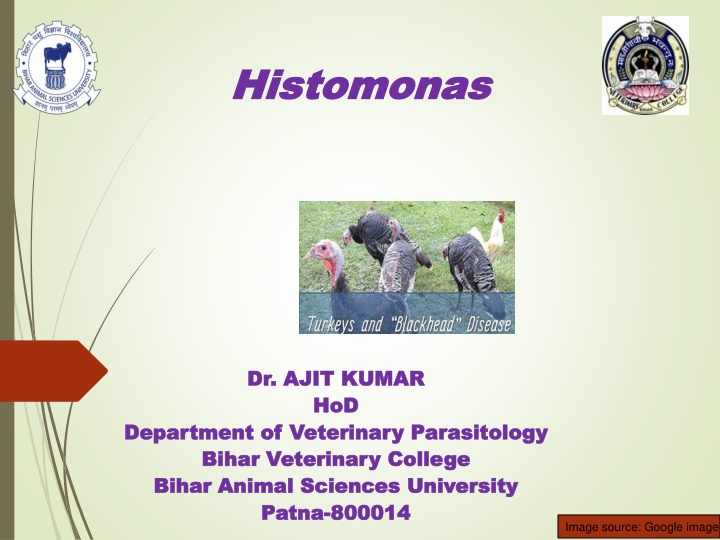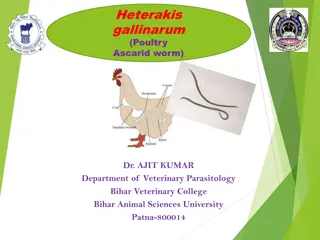
Histomonas meleagridis: Characteristics, Transmission, and Pathogenesis
Explore the characteristics of Histomonas meleagridis, a parasite affecting birds like turkeys, chickens, and quails. Learn about its morphology, stages, host range, mode of transmission, and pathogenesis, including the formation of circular necrotic lesions in the liver and caecum.
Download Presentation

Please find below an Image/Link to download the presentation.
The content on the website is provided AS IS for your information and personal use only. It may not be sold, licensed, or shared on other websites without obtaining consent from the author. If you encounter any issues during the download, it is possible that the publisher has removed the file from their server.
You are allowed to download the files provided on this website for personal or commercial use, subject to the condition that they are used lawfully. All files are the property of their respective owners.
The content on the website is provided AS IS for your information and personal use only. It may not be sold, licensed, or shared on other websites without obtaining consent from the author.
E N D
Presentation Transcript
Bihar Animal Sciences University | Histomonas Histomonas Dr. AJIT KUMAR Dr. AJIT KUMAR HoD HoD Department of Veterinary Parasitology Department of Veterinary Parasitology Bihar Veterinary College Bihar Veterinary College Bihar Animal Sciences University Bihar Animal Sciences University Patna Patna- -800014 800014 Image source: Google image
Family: Monocercomonadide Histomonas meleagridis Morphology Morphology : :- - o Organisms amoeboid (pleomorphic) with a single nucleus single flagellum. are and Image source: Google image
Histomonas meleagridis Morphology Morphology : :- - o Four Four stages stages of have have been been recognized of parasites parasites recognized : :- - I. I. Invasive Invasive stage, stage, II. II. Vegetative Vegetative stage, stage, III. III. Resistant Resistant stage stage and and stage. . IV. IV. flagellar flagellar stage Image source: Google image
Histomonas meleagridis o Host : Turkey (mainly) but also in chicken, pheasant, partridge and quail. Image source: Google image
Histomonas meleagridis o Location : Caecal mucosa and liver parenchyma o Reproduction :- By binary fission Image source: Google image
Histomonas meleagridis Mode of Transmission: Transmission takes place in birds by embryonated eggs of the caecal worm gallinarum) Histomonas organism. ingestion of (Heterakis containing meleagridis
Histomonas meleagridis Mode of Transmission: Infection of birds may also occur by the ingestion of earthworm transport host for Heterakis eggs and larvae. which is
Histomonas meleagridis Pathogenesis :- Histomonosis yellowish caseous plug in caecum and formed circular necrotic depressed centre (bulls eye appearance) in liver. produces exudates foul smelling a hard forming foci with yellow Circular necrotic lesions Circular necrotic lesion s in caecum Image source: Google image
Histomonas meleagridis Disease: o It Histomonosis Histomonosis enterohepatitis enterohepatitis or in in turkey turkey. caused diseases or or or Black Black head is Infectious Infectious head disease disease called
Histomonas meleagridis o Symptoms: o Sulphur Sulphur yellow yellow especially in turkeys which is not common sign in chicken. o A few turkeys discoloration of the skin of the head and wattles from which black head name arises but it is not a constant feature of the disease. coloured coloured faeces faeces shows cyanotic
Histomonas meleagridis Diagnosis: On the basis of symptoms like Sulphur yellow yellow coloured coloured faeces faeces etc Sulphur etc. . Characteristic Characteristic necrotic in in caecum caecum and examination examination. necrotic lesions and liver liver lesions found during during P P. .M found M. .
Treatment of Histomonas meleagridis Furazolidone, Dimetridazole, Nithiazide and 2-amino 5- nitrothiozole drugs are used in treatment.
Control of Histomonas meleagridis o Adoption of hygienic measures, o Avoiding overcrowding and prevent contamination of feed and drinking water with droppings, o separate rearing of different species of birds.

